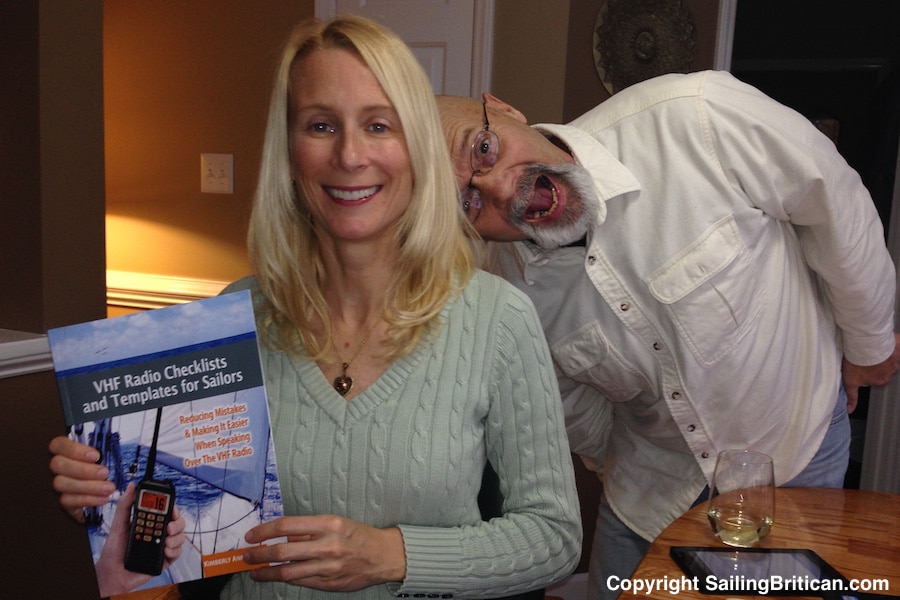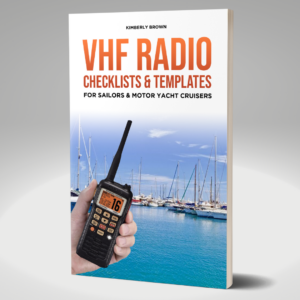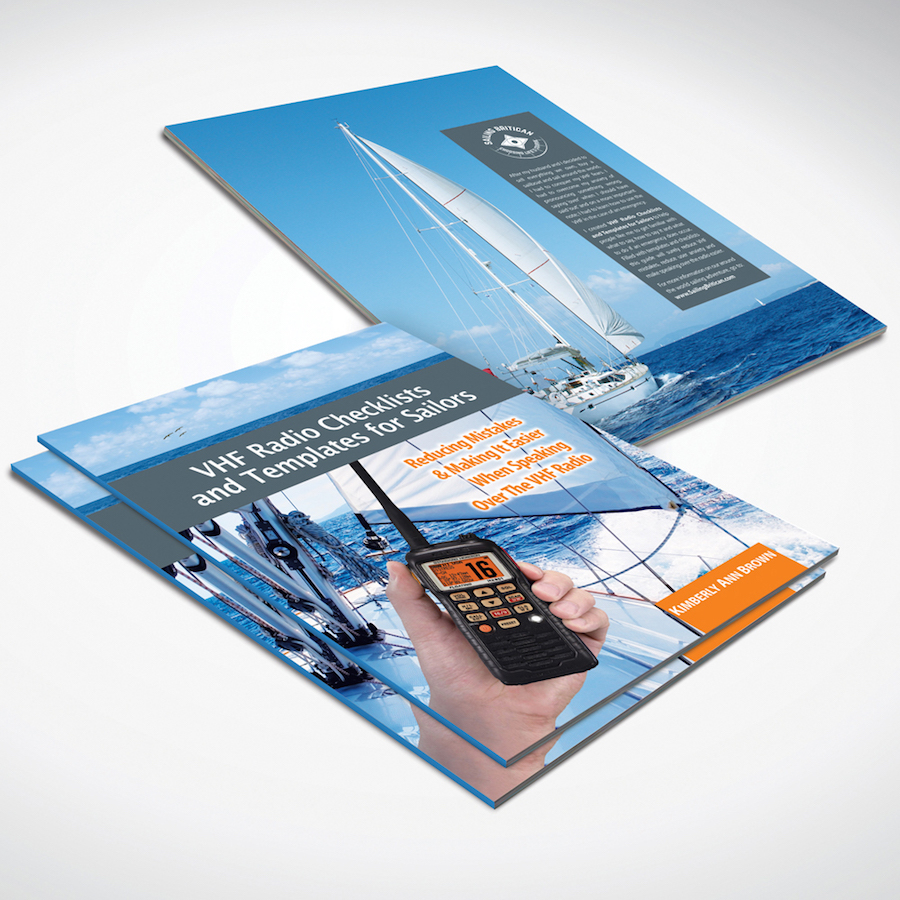Here’s a resource that will allow you to know everything you need to know about VHF radio etiquette. Discover how you can know what to say, how to say it and when to say it. But first, let me back up a bit.
When I was a new sailor, I thought it was only me that balked at the idea of having to make a VHF radio broadcast and understanding VHF radio etiquette.
My husband, Simon, went to extreme measures to try and get me to make a call. He’d say that he couldn’t leave the cockpit and yell, ‘just make the call.’
I, of course, yelled back, ‘I’ll steer, YOU make the call!’
Looking back, all I had to do was say, ‘Port Solent, Port Solent, this is Selene, Selene, over.’ And when the marina responded, I just had to let them know we were ready to enter the lock system and request instructions. (Selene was the name of our last boat).
I’m not sure why I was afraid of making a call?
Perhaps I was scared that I’d make a mistake? Perhaps I’d pronounce the marina name wrong, say the wrong thing or say ‘over’ when I should have said ‘out?’ And the fact that several people could potentially hear gave me some sort of ‘stage freight.’ Perhaps there’s a known term called ‘radio fright?’ I suppose that VHF radio etiquette isn’t the same as simply talking…and I didn’t have any experience in doing it.
And, I hate to admit this but I often feel like there’s a load of salty sea dogs or men who call themselves ‘Captain,’ judging us women on the seas. Before I make a call I can hear them say, ‘There’s another one messing up what used to be our perfect world.’
Don’t get me wrong – I’m not anti-men!
I love men and for the most part, I get on with men. It’s just that the sailing world is still very male-dominated and some of the salty sea dogs are not very nice to us want-to-be-cool-while-sailing women folk.
Anyway, as time went on and we had more and more visitors on our boat, I noticed that everyone tried to avoid making a VHF call – young and old, male and female, sober or tipsy. It wasn’t just me! VHF radio etiquette is not something that just comes naturally.
Only a couple brave souls volunteered to make a broadcast and it was only after listening to Simon several times that they’d give it a go. One friend wrote down everything they wanted to say and practiced for quite a while before they made the call and that got me thinking.
What the sailing world needs is a dummy’s guide to VHF radio etiquette!
Heck, I needed the guide and I witnessed others that desired assistance when first starting out. I went on a hunt to find templates that could be used for the routine VHF radio broadcasts.
The best I could find was one MAYDAY template and that’s it!
Surely, I thought, there is a collection of templates for making a Pan-Pan’s, Securite, requesting radio medical advice, and a standard protocol template for calling another boat, and others?
To my surprise, I couldn’t find anything, so I made my own guide
One in which I could fill in the blanks. For example, I wrote down all the generic text, inserted my boat specific information like MMSI, Call Sign and boat name and the left spaces for descriptors such as longitude/latitude, the reason for distress, time of day and so forth.
I laminated each broadcast template and put it in a folder for future use
By laminating the templates, I was then able to use a whiteboard marker to write event-specific information and later wipe it off reducing the need for several copies. Furthermore, the lamination protected the template from the sometimes damp conditions on the boat!
The result was a booklet of every potential VHF radio broadcast I could ever imagine having to do – all with my boat specific information and all written out so I simply had to decide on the call necessary, fill in the event-specific details and then pick up the radio microphone and make the call.
MAYDAY calls are an obvious one, but doing any kind of radio broadcast for the first several times does not come naturally. And especially when in an emergency, you don’t want to have to think – you just want to be able to do things quickly, calmly and efficiently.
I really couldn’t believe that nothing existed like a VHF radio broadcast template guide
First of all, there is very specific wording necessary for making broadcasts. Furthermore, in most cases, the average person won’t make any emergency calls over their lifetime; therefore what you don’t use you lose. Sure, you can take a VHF radio course but what happens when you need to request radio medical advice two years later?
Yes – you can ‘wing-it’ and disregard VHF radio etiquette…
…and I’m sure you’ll get assistance, however, to make sure that there’s less room for error, especially when a life might be at risk, wouldn’t you want a handy step-by-step guide and template available at all times?
Well, that’s why I created the guide, VHF Radio Checklists, and Templates for Sailors – Reducing mistakes & making it easier when speaking over the VHF radio.

I got photo-bombed by my stepfather – here’s me holding my VHF guide (and my step-dad)…
After showing several other cruisers my ‘guide,’ they’d ask for a copy. One cruiser said, ‘Hey, you should put this on Amazon so others can benefit.’
And as they say, the rest is history!
All that being noted, the 40+ page guide that I created does not replace or act as a substitution for a VHF radio course or a professional document. In the guide, I don’t explain how to use a radio although I do offer various tips and suggestions.
Here’s the Table of Contents
- Introduction 4
- Thank you and final comment 9
- VHF Radio General Tips and Information 11
- VHF Radio Checklists and Templates 27
- Using the VHF to call a boat or place 28
- Sending a MAYDAY Broadcast 29
- Sending a MAYDAY RELAY Broadcast 30
- Sending a PAN PAN Broadcast 31
- Sending a Broadcast to Request Medical Advice 32
- Sending a SÉCURITÉ message 33
- Canceling a VHF Alert 34
- Sending a RECEIVED MAYDAY Transmission 35
- Receiving a VHF Distress Message 36
- Appendix – Phonetic Alphabet Table 37
- Appendix – Phonetic Numerals Table 38
- Customized VHF Checklist and Template Guide (PDF) 39
- About Kim Brown 40
Within the first section of the guide, I offer an explanation of each type of call, what it’s for and provide a working example. In the second section of the guide, you’ll discover the various step-by-step instructions and fill-in-the-blank templates. I also included the phonetic alphabet and numerals table, used when making a VHF broadcast, for reference.
And, finally, within the guide, I offer instructions on how to get a FREE boat specific version of the guide!
With a boat specific version, the guide owner can then print, laminate and collate the templates for safekeeping in their navigation station!
So…who do you know that might feel nervous when making a VHF radio broadcast?
Could you please tell them about my VHF Radio Checklist and Templates for Sailors guide?
Buy the guide at my online store or pop over to Amazon (see below)
Buy the guide from Amazon
VHF Radio Checklist and Templates for Sailors (USA version on Amazon.com)
VHF Radio Checklist and Templates for Sailors (UK version on Amazon.co.uk )


I sail with my wife who will quiet happily use the radio to make the simple calls but it is the ones we never or rarely make which are the important life saving ones.
If I am incapacitated then having something like this would be ideal. She could pull the sheet up, read it out and know she had all the information, and even what to say in front of her.
A life saver and I will be getting your book. Thank you for this.
A nice app on iOS is Sea Weather Pro by appdoctors UG
https://appsto.re/ch/6cl5w.i
It not only give good weather info, but also prepares your VHF DSC mayday, pan pan, sécurité messages in a very easy way. Useful even if you got your SRC and LRC (and get forgetful like me :))
Thank you for the tip Marcel 🙂
Surely if we are talking etiquette here you really should mention that channel 16 is an international calling and distress channel. And should not used for selling cookies!!
Channel 16 is for hailing anyone – another boat, a marina…if you’re anchored off any Caribbean island, you use 16 to hail restaurants to make reservations, laundry service, ice suppliers, chandleries, etc. It is not however a channel where you do anything more than hail. Once contact has been made you immediately move to another working channel.
Exactly, Ch 16 is a calling channel, and not just for emergencies, its more than that, including a hailing channel. I’d like to add two more points to your excellent follow up. First is that not all facilities have the ability to monitor two channels and will often listens on a “known” channel, typically 69 or 72 for marinas. These channels can be found in adverts, almanacs, cruising guides, and so on. Often, locals hearing you hail on 16, will help you with the facility you are seeking listening channel. Next, to pick up on what Micheal says. All users should listen carefully before transmitting. If there is a ‘Mayday’ or ‘Pan Pan’ situation, you will hear the local coast guard or authorities saying “silence”, pronounced more “silonce”, or “prudence”, respectively. in these cases, you should not call up on 16 for anything less than an emergency and those cookies will have to wait! Finally, in most jurisdictions, there is a requirement to have a VHF licence where these short of things are taught, You can however, use a VHF under the guidance of someone with a licence, or in an emergency, so get practicing!
Another thing I would recommend is becoming familiar with standard phraseology when responding to a request for a radio check.
“Vessel calling for radio check, you’re 5 by 5.” (or substituting the appropriate lower numbers if the readability and strength of their transmission is of poorer quality than that.)
https://en.m.wikipedia.org/wiki/Signal_strength_and_readability_report
You can also use plain language responses such as “”Weak but readable,” “Strong but distorted,” “Loud and clear,” “Strength Four,” etc.” although in my opinion this leads to more subjectivity in the response and is of less value to the station that asked for the radio check than the numerical system.
Is there a downloadable version that I can buy today online?
Hey Andrew – yes, you can find it here: https://sailingbritican.com/vhf-radio-checklists-for-sailors-guide/